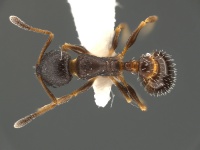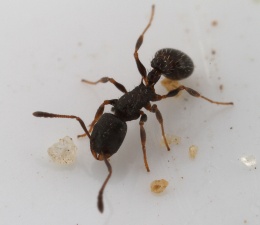Temnothorax texanus
| Temnothorax texanus | |
|---|---|

| |
| Scientific classification | |
| Kingdom: | Animalia |
| Phylum: | Arthropoda |
| Class: | Insecta |
| Order: | Hymenoptera |
| Family: | Formicidae |
| Subfamily: | Myrmicinae |
| Tribe: | Crematogastrini |
| Genus: | Temnothorax |
| Species group: | sallei |
| Species: | T. texanus |
| Binomial name | |
| Temnothorax texanus (Wheeler, W.M., 1903) | |
| Synonyms | |
| |
Nests in the ground with a preference for open or semi-open sites having sandy or clay soils (e.g., reported as being found in sand dunes, oak-rosemary xeric hummocks, turkey oak scrub) . The nest consists of a few chambers, 3 - 4 inches long, that are just a few inches below the surface. The nest entrance may be located at the base of a clump of grass. Workers will forage under litter or on exposed surfaces where they collect small insects and presumably any other food items they encounter. Monogynous. (Based on Wheeler 1905, Talbot 1934, Wesson and Wesson 1940, Smith 1952, Van Pelt 1958, Carter 1962, MacKay 2000)
Identification
Prebus (2017) - A member of the sallei clade.
Mackay (2000) - This is a small (total length 2.25mm), dark brown species with a 12-segmented antenna, in which the postpetiole is more than 1.5 X the width of the petiole. The entire ant is roughly sculptured, with rugae on the head, top and side of the mesosoma, on the petiole and on the postpetiole. The gaster is smooth and glossy. The subpeduncular process is poorly defined and consists of a tiny tooth. The node of the petiole is truncate, the propodeum has well-developed spines.
In the Southeast this species and the larger Temnothorax pergandei are the only dark, shining Temnothorax found foraging on the ground in open areas. Some southeastern queens are blackish, others a striking brick red.
Keys including this Species
- Key to Temnothorax tricarinatus species group workers
- Key to the New World Temnothorax
- Key to Temnothorax of eastern United States
Distribution
Central Florida west to Texas, north to New Jersey.
Latitudinal Distribution Pattern
Latitudinal Range: 46.985263° to 19.19388°.
| North Temperate |
North Subtropical |
Tropical | South Subtropical |
South Temperate |
- Source: AntMaps
Distribution based on Regional Taxon Lists
Nearctic Region: United States (type locality).
Neotropical Region: Mexico.
Distribution based on AntMaps
Distribution based on AntWeb specimens
Check data from AntWeb
Countries Occupied
| Number of countries occupied by this species based on AntWiki Regional Taxon Lists. In general, fewer countries occupied indicates a narrower range, while more countries indicates a more widespread species. |

|
Estimated Abundance
| Relative abundance based on number of AntMaps records per species (this species within the purple bar). Fewer records (to the left) indicates a less abundant/encountered species while more records (to the right) indicates more abundant/encountered species. |

|
Habitat
Open sites with sandy or clay soils.
Abundance
Common.
Biology
Atchison & Lucky (2022) found that this species does not remove seeds.
Nesting Habits
| Temnothorax sp. | Acorns / hickory nuts | Sticks / dead roots in leaf litter | Rotten logs / dead standing trees | Hollow plant stems | Rock crevices | Formica nests | Nests of other Temnothorax spp. | Under rock / directly in soil | Galls | Under bark on live trees | Hollow twigs on live trees | Branches on live trees |
|---|---|---|---|---|---|---|---|---|---|---|---|---|
| Temnothorax allardycei | – | x | – | x | – | – | – | – | – | – | x | – |
| Temnothorax ambiguus | x | x | – | x | – | x | – | x | – | – | – | – |
| Temnothorax americanus | x | x | – | – | – | – | x | – | – | – | – | – |
| Temnothorax bradleyi | – | – | – | – | – | – | – | – | – | x | – | – |
| Temnothorax caryaluteus | – | – | – | – | – | – | – | – | – | x | x | x |
| Temnothorax curvispinosus | x | x | x | x | – | – | – | x | x | x | – | – |
| Temnothorax duloticus | x | x | – | – | – | – | x | – | – | – | – | – |
| Temnothorax longispinosus | x | x | x | – | x | – | – | x | – | – | – | – |
| Temnothorax minutissimus | x | – | – | – | – | – | x | – | – | – | – | – |
| Temnothorax palustris | – | – | – | – | – | – | – | x | – | – | – | – |
| Temnothorax pergandei | x | x | x | x | x | – | – | x | – | – | – | – |
| Temnothorax pilagens | x | x | – | – | – | – | x | – | – | – | – | – |
| Temnothorax schaumii | – | – | x | – | – | – | – | – | x | x | x | x |
| Temnothorax smithi | – | – | x | – | – | – | – | – | – | x | – | – |
| Temnothorax texanus | – | – | – | – | – | – | – | x | – | – | – | – |
| Temnothorax torrei | – | x | – | – | – | – | – | – | – | – | – | – |
| Temnothorax tuscaloosae | x | x | – | – | – | – | – | x | – | – | – | – |
Regional Notes
Texas
All three sexual phases of this species were taken May 23, 1902, in nests consisting of a few small galleries, 3-4 inches long, excavated in the sand in rather damp spots under post-oaks and cedars. (Wheeler 1903)
Ohio
Several colonies of this species were found nesting in sandy soil under pine needles on the edge of dry, open sandstone bluffs in Jackson County. The workers ran about very rapidly in the sun over the pine needles. Winged phases were taken from a nest in early July. (Wesson and Wesson 1940)
Life History Traits
- Queen number: monogynous (Frumhoff & Ward, 1992)
Castes
Queen color can vary. Wheeler (1903) described the queen as "color of head, thorax and pedicel reddish-brown, darker on the dorsal surface. Gaster black." Deyrup and Cover (2004) reported "some southeastern queens are blackish, others a striking brick red."
Worker
   
| |
| . | Owned by Museum of Comparative Zoology. |
Images from AntWeb
  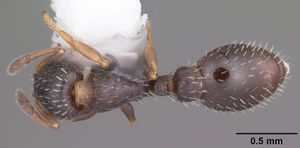 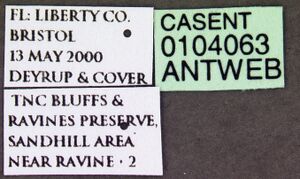
| |
| Worker. Specimen code casent0104063. Photographer April Nobile, uploaded by California Academy of Sciences. | Owned by ABS, Lake Placid, FL, USA. |
Queen
Images from AntWeb
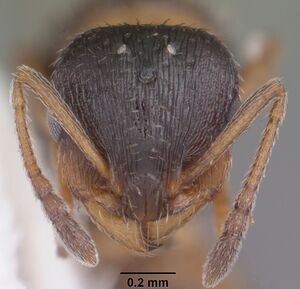  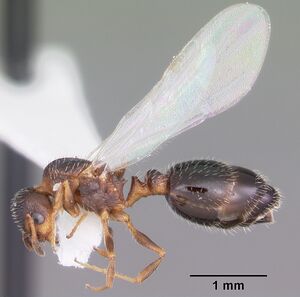 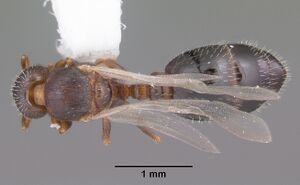 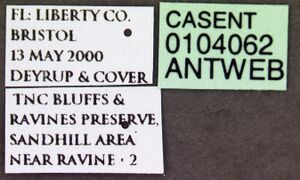
| |
| Queen (alate/dealate). Specimen code casent0104062. Photographer April Nobile, uploaded by California Academy of Sciences. | Owned by ABS, Lake Placid, FL, USA. |
Male
Images from AntWeb
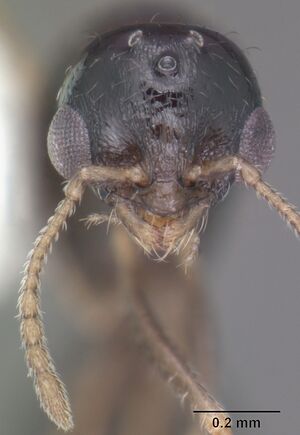    
| |
| Male (alate). Specimen code casent0104065. Photographer April Nobile, uploaded by California Academy of Sciences. | Owned by ABS, Lake Placid, FL, USA. |
Nomenclature
The following information is derived from Barry Bolton's Online Catalogue of the Ants of the World.
- texanus. Leptothorax texanus Wheeler, W.M. 1903c: 245, pl. 12, fig. 16 (w.q.m.) U.S.A. Wheeler, G.C. & Wheeler, J. 1960b: 24 (l.). Combination in L. (Myrafant): Smith, M.R. 1950a: 30; in Temnothorax: Bolton, 2003: 272. Senior synonym of davisi: Deyrup & Cover, 2004a: 56. See also: Smith, M.R. 1952b: 102; Mackay, 2000: 415.
- davisi. Leptothorax texanus subsp. davisi Wheeler, W.M. 1905f: 385 (w.q.) U.S.A. Combination in L. (Myrafant): Smith, D.R. 1979: 1395; in Temnothorax: Bolton, 2003: 271. Raised to species: Mackay, 2000: 340. Junior synonym of texanus: Deyrup & Cover, 2004a: 56. See also: Smith, M.R. 1952b: 104.
Unless otherwise noted the text for the remainder of this section is reported from the publication that includes the original description.
Description
Worker
Length 2.25-2.75 mm. Head longer than broad. Eyes rather large. Mandibles 5-toothed. Clypeus moderately convex, its anterior border somewhat rounded. Antennae 12-jointed; scape reaching nearly to the posterior angle of the head; funiculus terminating in a very distinct 3-jointed club, the last joint of which is somewhat longer than the two preceding joints; first funicular joint nearly as long as joints 2-5; second funicular joint about as long as broad, the remaining joints broader than long. Thorax rather short, its humeral angles rounded, dorsum evenly and slightly rounded, without mesoepinotal constriction. Epinotal spines moderate, distinctly shorter than the declivous surface of the epinotum, scarcely as long as their distance apart at the base, rapidly tapering, acute, directed upward, outward and backward. their tips slightly deflected. Petiole from above fully 1 1/2 times as long as broad; its sides somewhat convex, so that its outline is subelliptical; in profile the anterior slope is abrupt and distinctly concave, the summit of the node flattened, and the posterior slope suddenly declivous; ventral tooth small, acute, directed downward. Postpetiole very large, fully twice as broad as the petiole; broader than long, its anterior and posterior angles rounded, so that it appears transversely elliptical from above; in profile it is very convex, especially in front. Gaster elliptical, depressed, without distinct anterior angles.
Mandibles coarsely striated. Clypeus traversed by several clean-cut longitudinal rugae, subsiding on the posterior portion which is smooth and shining. Head subopaque, coarsely reticulate-rugose; the rugae distinctly longitudinal only on the front and vertex; interrugal spaces secondarily reticulate. Neck evenly reticulate; thoracic dorsum very coarsely and irregularly reticulate-rugose; the, spaces between the rugae smooth and shining, because the secondary reticulation is indistinct or lacking. Pleurae somewhat more delicately and evenly rugose. Petiole and postpetiole coarsely reticulate-rugose, interrugal spaces filled with shallow foveolae or secondary reticulation. Gaster smooth and shining.
Hairs white, rather numerous and prominent; on the trunk clavate; shorter and more erect on the head and thorax"longer and slightly reclinate on the pedicel and gaster; on the legs and antennae distinct, non-clavate, more or less appressed.
Black or very dark-brown, especially on the head, thorax and petiole. Mandibles, excepting the teeth, funiculus, tips of epinotal spines, tarsi and articulations of legs, excepting the last tarsal joint, yellow; antennal scape brown.
Queen
Length 3.75-4 mm. Head more decidedly and extensively longitudinally rugose than in the worker. Neck delicately, pronotum more coarsely reticulate-rugose; mesonotum and paraptera traversed by numerous longitudinal rugae which are more or less interrupted and have a tendency to anastomose. Scutellum with such rugae only in front and on the sides, posteriorly it is nearly smooth and shining. Pleural and epinotum with rather coarse, distinctly longitudinal rugae. Epinotal spines small, acute, straight. Petiole with pointed node and more abruptly declivous posterior slope than in the worker, its dorsal surface scarcely flattened. Postpetiole very convex in front above. Sculpturing of petiole and postpetiole as in the worker.
Color of head, thorax and pedicel reddish-brown, darker on the dorsal surface. Gaster black. Pilosity of body and legs and color of the latter much as in the worker. Wings whitish-hyaline; veins and stigma yellow.
Male
Length 2-2.5 mm. Head exclusive of the mandibles broader than long, cheeks short, posterior angles convex and rounded. Mandibles overlapping each other. Antennae 13-jointed; scape as long as the first four joints of the funiculus, club very distinct, 4-jointed, the first, second and third subequal, fully 1 1/2 times as long as broad, apical joint as long as the second and third together; first funicular joint somewhat swollen, fully 1 1/2 times as long as broad; joints 2-8 longer than broad. Epinotum with two very small, indistinct protuberances in the place of the spines. Petiole slender, in profile concave below; anterior dorsal slope nearly straight, gradual, posterior slope shorter, abruptly declivous, rather concave. Postpetiole campanulate, about as long as broad; 1 1/2 times as broad as the petiole. Legs long and slender.
Mandibles striated. Clypeus coarsely and irregularly reticulate-rugose, shining. Head subopaque, evenly and rather delicately reticulate-rugose. Neck finely reticulate; mesonotum shining, with a faint reproduction of the irregular rugosity of the worker; remainder of thorax and the pedicel delicately reticulate-punctate. Gaster smooth and shining.
Hairs white, non-clavate, long and moderately abundant on the mandibles, pedicel and gaster; sparser elsewhere.
Black; mandibles and genitalia yellow; antennal funiculus grayish brown; wings like those of female; legs like those of the worker in color.
Type Material
Mackay (2000) - USA. Milano, Millan County, TX. American Museum of Natural History, Museum of Comparative Zoology [seen].
Etymology
Toponym. Types collected in Texas.
References
- Atchison, R. A., Lucky, A. 2022. Diversity and resilience of seed-removing ant species in Longleaf Sandhill to frequent fire. Diversity 14, 1012 (doi:10.3390/d14121012).
- Bolton, B. 2003. Synopsis and Classification of Formicidae. Mem. Am. Entomol. Inst. 71: 370pp (page 272, Combination in Temnothorax)
- Carroll, T.M. 2011. The ants of Indiana (Hymenoptera: Formicidae). M.S. thesis, Purdue University.
- Carter, W. G. 1962. Ant distribution in North Carolina. Journal of the Elisha Mitchell Scientific Society. 78:150-204.
- Deyrup, M.; Cover, S. 2004b. A new species of the ant genus Leptothorax from Florida, with a key to the Leptothorax of the southeast (Hymenoptera: Formicidae). Fla. Entomol. 87(1): 51-59 (page 56, senior synonym of davisi)
- Ivanov, K. 2019. The ants of Ohio (Hymenoptera, Formicidae): an updated checklist. Journal of Hymenoptera Research 70: 65–87 (doi:10.3897@jhr.70.35207).
- MacKay, W. P. 2000. A review of the New World ants of the subgenus Myrafant, (genus Leptothorax) (Hymenoptera: Formicidae). Sociobiology 36: 265-444 (page 415, see also)
- Moura, M.N., Cardoso, D.C., Cristiano, M.P. 2020. The tight genome size of ants: diversity and evolution under ancestral state reconstruction and base composition. Zoological Journal of the Linnean Society, zlaa135 (doi:10.1093/zoolinnean/zlaa135).
- Prebus, M. 2017. Insights into the evolution, biogeography and natural history of the acorn ants, genus Temnothorax Mayr (hymenoptera: Formicidae). Bmc Evolutionary Biology. 17:250. doi:10.1186/s12862-017-1095-8 (The doi link to the publication's journal webpage provides access to the 24 files that accompany this article).
- Prebus, M.M. 2021. Taxonomic revision of the Temnothorax salvini clade (Hymenoptera: Formicidae), with a key to the clades of New World Temnothorax. PeerJ 9, e11514 (doi:10.7717/peerj.11514).
- Prebus, M.M., Nguyen, N., Doering, G.N., Booher, D.B. 2024. Temnothorax caryaluteus sp. nov. (Hymenoptera: Formicidae): a new ant species from the eastern United States. European Journal of Taxonomy 970, 175–202 (doi:10.5852/ejt.2024.970.2757).
- Smith, M. R. 1952c. North American Leptothorax of the tricarinatus-texanus complex (Hymenoptera: Formicidae). J. N. Y. Entomol. Soc. 60: 96-106 (page 102, see also)
- Talbot, M. 1934. Distribution of ant species in the Chicago region with reference to ecological factors and physiological toleration. Ecology. 15:416-439.
- Van Pelt, A. F. 1958. The ecology of the ants of the Welaka Reserve, Florida (Hymenoptera: Formicidae). Part II. Annotated list. American Midland Naturalist. 59:1-57.
- Wesson, L. G. and R. G. Wesson. 1940. A collection an ants from southcentral Ohio. American Midland Naturalist. 24:89-103
- Wheeler, G. C.; Wheeler, J. 1960b. Supplementary studies on the larvae of the Myrmicinae (Hymenoptera: Formicidae). Proc. Entomol. Soc. Wash. 62: 1-32 (page 24, larva described)
- Wheeler, W. M. 1903d. A revision of the North American ants of the genus Leptothorax Mayr. Proc. Acad. Nat. Sci. Phila. 55: 215-260 (page 245, pl. 12, fig. 16 worker, queen, male described)
- Wheeler, W. M. 1905. An annotated list of the ants of New Jersey. Bulletin of the American Museum of Natural History. 21:371-403.
References based on Global Ant Biodiversity Informatics
- Annotated Ant Species List Ordway-Swisher Biological Station. Downloaded at http://ordway-swisher.ufl.edu/species/os-hymenoptera.htm on 5th Oct 2010.
- Atchison R. A., J. Hulcr, and A. Lucky. 2018. Managed fire frequency significantly influences the litter arthropod community in longleaf pine flatwoods. Environmental Entomology 20(10): 1-11.
- Cancino, E.R., D.R. Kasparan, J.M.A. Coronado Blanco, S.N. Myartseva, V.A. Trjapitzin, S.G. Hernandez Aguilar and J. Garcia Jimenez. 2010. Himenópteros de la Reserva El Cielo, Tamaulipas, México. Dugesiana 17(1):53-71
- Carroll T. M. 2011. The ants of Indiana (Hymenoptera: Formicidae). Master's Thesis Purdue university, 385 pages.
- Coovert G. A. 2005. The Ants of Ohio (Hymenoptera: Formicidae). Ohio Biological Survey, Inc. 15(2): 1-207.
- Coovert, G.A. 2005. The Ants of Ohio (Hymenoptera: Formicidae) Ohio Biological Survey Bulletin New Series Volume 15(2):1-196
- Dash S. T. and L. M. Hooper-Bui. 2008. Species diversity of ants (Hymenoptera: Formicidae) in Louisiana. Conservation Biology and Biodiversity. 101: 1056-1066
- Dattilo W. et al. 2019. MEXICO ANTS: incidence and abundance along the Nearctic-Neotropical interface. Ecology https://doi.org/10.1002/ecy.2944
- Dean D. A., and S. R. Dean. 2018. A survey of the ant fauna and seasonal alate nuptial flights at two locations in South-Central Texas. Southwestern Entomologist 43(3): 639-647.
- Del Toro, I. 2010. PERSONAL COMMUNICATION. MUSEUM RECORDS COLLATED BY ISRAEL DEL TORO
- Deyrup M., C. Johnson, G. C. Wheeler, J. Wheeler. 1989. A preliminary list of the ants of Florida. Florida Entomologist 72: 91-101
- Deyrup, M. and J. Trager. 1986. Ants of the Archbold Biological Station, Highlands County, Florida (Hymenoptera: Formicidae). Florida Entomologist 69(1):206-228
- Forster J.A. 2005. The Ants (hymenoptera: Formicidae) of Alabama. Master of Science, Auburn University. 242 pages.
- Frye J. A., T. Frye, and T. W. Suman. 2014. The ant fauna of inland sand dune communities in Worcester County, Maryland. Northeastern Naturalist, 21(3): 446-471.
- Graham J.H., H.H. Hughie, S. Jones, K. Wrinn, A.J. Krzysik, J.J. Duda, D.C. Freeman, J.M. Emlen, J.C. Zak, D.A. Kovacic, C. Chamberlin-Graham, H. Balbach. 2004. Habitat disturbance and the diversity and abundance of ants (Formicidae) in the Southeastern Fall-Line Sandhills. 15pp. Journal of Insect Science. 4: 30
- Graham, J.H., A.J. Krzysik, D.A. Kovacic, J.J. Duda, D.C. Freeman, J.M. Emlen, J.C. Zak, W.R. Long, M.P. Wallace, C. Chamberlin-Graham, J.P. Nutter and H.E. Balbach. 2008. Ant Community Composition across a Gradient of Disturbed Military Landscapes at Fort Benning, Georgia. Southeastern Naturalist 7(3):429-448
- Ivanov, K. 2019. The ants of Ohio (Hymenoptera, Formicidae): an updated checklist. Journal of Hymenoptera Research 70: 65–87.
- Johnson C. 1986. A north Florida ant fauna (Hymenoptera: Formicidae). Insecta Mundi 1: 243-246
- Lubertazzi D. and Tschinkel WR. 2003. Ant community change across a ground vegetation gradient in north Floridas longleaf pine flatwoods. 17pp. Journal of Insect Science. 3:21
- MacGown J. A., J. G. Hill, and M. Deyrup. 2009. Ants (Hymenoptera: Formicidae) of the Little Ohoopee River Dunes, Emanuel County, Georgia. J. Entomol. Sci. 44(3): 193-197.
- MacGown, J.A and J.A. Forster. 2005. A preliminary list of the ants (Hymenoptera: Formicidae) of Alabama, U.S.A. Entomological News 116(2):61-74
- Mackay W. P. 2000. A review of the New World ants of the subgenus Myrafant, (genus Leptothorax) (Hymenoptera: Formicidae). Sociobiology 36: 265-444.
- Mackay W. P., and E. E. Mackay. 2002. The ants of New Mexico (Hymenoptera: Formicidae). Lewiston, New York: Edwin Mellen Press, 400 pp.
- Mackay, W., D. Lowrie, A. Fisher, E. Mackay, F. Barnes and D. Lowrie. 1988. The ants of Los Alamos County, New Mexico (Hymenoptera: Formicidae). pages 79-131 in J.C. Trager, editor, Advances in Myrmecololgy.
- Michigan State University, The Albert J. Cook Arthropod Research Collection. Accessed on January 7th 2014 at http://www.arc.ent.msu.edu:8080/collection/index.jsp
- O'Keefe S. T., J. L. Cook, T. Dudek, D. F. Wunneburger, M. D. Guzman, R. N. Coulson, and S. B. Vinson. 2000. The Distribution of Texas Ants. The Southwestern Entomologist 22: 1-92.
- Roeder K. A., and D. V. Roeder. 2016. A checklist and assemblage comparison of ants (Hymenoptera: Formicidae) from the Wichita Mountains Wildlife Refuge in Oklahoma. Check List 12(4): 1935.
- Smith M. R. 1935. A list of the ants of Oklahoma (Hymen.: Formicidae). Entomological News 46: 235-241.
- Smith M. R. 1952. North American Leptothorax of the tricarinatus-texanus complex (Hymenoptera: Formicidae). Journal of the New York Entomological Society 60: 96-106.
- Sturtevant A. H. 1931. Ants collected on Cape Cod, Massachusetts. Psyche (Cambridge) 38: 73-79
- Talbot M. 1976. A list of the ants (Hymenoptera: Formicidae) of the Edwin S. George Reserve, Livingston County, Michigan. Great Lakes Entomologist 8: 245-246.
- Van Pelt A., and J. B. Gentry. 1985. The ants (Hymenoptera: Formicidae) of the Savannah River Plant, South Carolina. Dept. Energy, Savannah River Ecology Lab., Aiken, SC., Report SRO-NERP-14, 56 p.
- Vásquez-Bolaños M. 2011. Lista de especies de hormigas (Hymenoptera: Formicidae) para México. Dugesiana 18: 95-133
- Wheeler G. C., J. N. Wheeler, and P. B. Kannowski. 1994. Checklist of the ants of Michigan (Hymenoptera: Formicidae). The Great Lakes Entomologist 26(4): 297-310
- Wheeler G. C., and J. Wheeler J. 1989. A checklist of the ants of Oklahoma. Prairie Naturalist 21: 203-210.
- Wheeler W. M. 1903. A revision of the North American ants of the genus Leptothorax Mayr. Proceedings of the Academy of Natural Sciences of Philadelphia. 55: 215-260.
- Wheeler, G.C. and J. Wheeler. 1985. A checklist of Texas ants. Prairie Naturalist 17:49-64.
- Wheeler, G.C., J. Wheeler and P.B. Kannowski. 1994. CHECKLIST OF THE ANTS OF MICHIGAN (HYMENOPTERA: FORMICIDAE). Great Lakes Entomologist 26:1:297-310
- Young J., and D. E. Howell. 1964. Ants of Oklahoma. Miscellaneous Publication. Oklahoma Agricultural Experimental Station 71: 1-42.
- Young, J. and D.E. Howell. 1964. Ants of Oklahoma. Miscellaneous Publications of Oklahoma State University MP-71

